#anti anti katara
Text
Air Temple Island, the Water Tribes & the Real Life Influences that bring them together
I was gonna screenshot a post I saw and add it to my post but I don’t feel like giving that individual attention (and the 300+ notes they got), so I just decided to make my own standalone post debunking this narrative that air temple island is this fully air nomad brothel (yes they said this) with ZERO water tribe motifs which katara is forced to live in until aang passed away.
frankly it just reminded me of how little people in this fandom actually bother to analyze the actual content, instead preferring to write entirely made up scenarios of katara being reduced to an air nomad incubator along with dozens other female acolytes (yes they also said this lmao. also them acting like both male AND female acolytes weren’t living on the whole other side of the island 😭)
when in truth, i’ve come to find a lot of elements of both water tribes as well as traditional inuit elements across air temple island:
1. the paifang
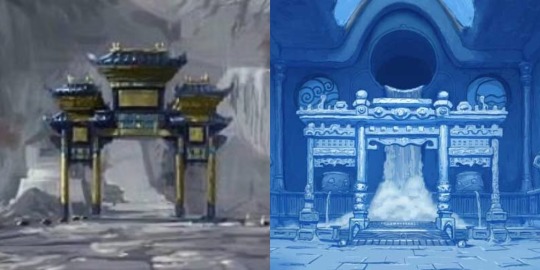
a traditionally chinese element that for some reason is exclusively found in the northern water tribe (why do they have a gate inside a throne room, you ask? ask the white people that made this show). the one on the left is actually one of two aang BUILT, at the main entrance and another at the temple entrance. this is just one example of water tribe design on the island.
2. the bagua mosaic

another structure is the bagua mosaic on the training grounds. bagua is a set of traditional chinese symbols of the cosmology, taoism. the bagua composes of 8 sets of broken or unbroken lines that represent yin and yang. where have we seen yin and yang in the original series? oh yeah, as tui and la of the water tribe! (because atla is a mess of asiatic and indigenous motifs joined together and spread out across each nation, mainly traditionally chinese elements at that.) aang building this right next to the air nomad training grounds is a symbol of the dual bending heritage their children will have.
3. gold and blue accents

now, gold and blue are the main colors of the exterior structures but is also very strong inside the air temple itself. note, the massive air nomad symbol designed fully in blue in the center and the blue banners and rugs throughout the temple. this is no doubt, for me, a visual depiction of both katara and aang’s representative cultures, but of course this is not limited to color only.
4. cloud carvings
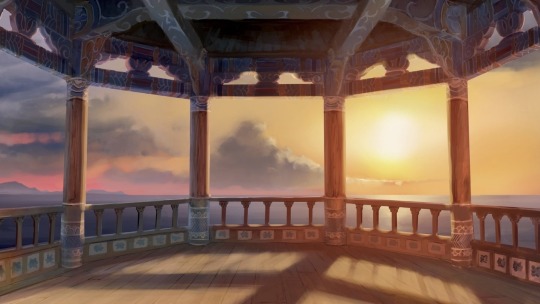
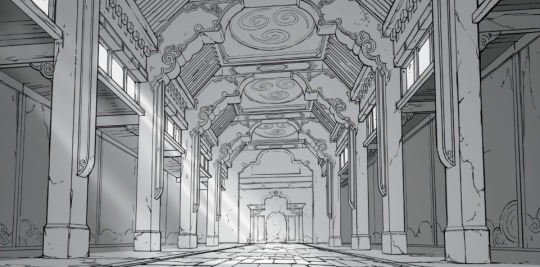
now, this is a slight detour since clouds aren’t a significant part of either of their individual cultures (that we know) but i love the kataang monopoly they have on clouds as a couple so i’m talking about it. if you look at these images very closely what do you see? CLOUD CARVINGS!! specifically near the ceiling of the pavilion (left) and the arches and walls of the temple (right) just imagining aang painting and etching these very consistent swirls, like he’ll never be the selfish inconsiderate unromantic loser you people want him to be, but let’s get more into the southern water tribe style interior.
5. interior design

so here is a southern water tribe white lotus outpost vs the air temple island main dining room. first thing, the seat cushions and rug! while we don’t see air nomad eating quarters we do get to see enough SWT customs both in atla and lok, to know this is how they traditionally eat compared to the north (limiting myself on pics cuz mobile).
another thing is the dining table itself. both have what i believe to be built in fire pits (i couldn’t actually tell for the air temple island one cuz of the quality but if you zoom in you can see the lines go in the table plus the hanging kettle on it makes it obvious to me idk). the southern water tribe one however is clear and likely a more traditional version of what aang and katara have.
thirdly, the exposed timber on the ceiling. i actually looked it up and found this is a common element of these two inuit structures: left is an aasiaat peat house and right is an igloolik turf house. all this for me to believe not only did aang build air temple island to be a haven for the TWO of them but also that katara herself had a lot of input on the interior than people care to notice lol.
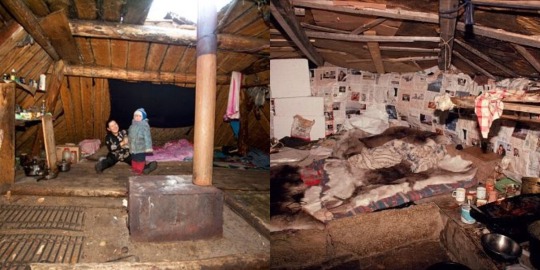
maybe instead of projecting these loser fantasies of katara being some unwilling air nomad baby making machine so you can feel better about your fantasies of katara living in a red palace with people that tried to wipe her out for a whole century, you all can go study the actual canon you were shown and the real life cultures the franchise takes from.
6. lastly, some of my own headcanons/stuff i want to see in the movie
the bathroom because I LIVE for a white marble tiled bathroom. i just know katara has to have a HUGE tub and they have one of those insane glass showers that can fit like 3 people, with cloud swirls everywhere because aang clearly got it like that
the KITCHEN, i imagine it being timber like the dining room and is probably on the other side behind the built-in shelf (get into the details like hello). in a perfect world, it would be open plan but hey
the bedroom, now we saw it in lok a bit but i wanna see it in the gaang movie too. i’m on pic limit but there’s a lot of artwork and flowers throughout the whole house which i give katara credit for because I can. like the desk, the bookshelf, that fancy looking vase thing? these two clearly have taste like don’t talk to me rn
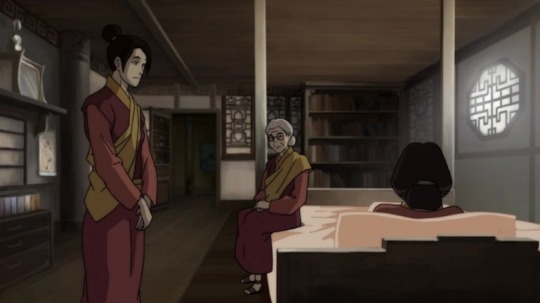
I also didn’t show the rooms and aang’s study but there’s a lot of blue decor in those places which makes me think katara decorated the whole house, even the acolytes’ hall has blue sitting cushions and columns which i think is such a nice detail.

if you guys have any air temple island headcanons of your own please reply with some i’m feening lol
big shoutout to this user:
atla-annotated (their page is so great and filled with a lot of incredible information if you guys like this sort of stuff)
#atla#kataang#anti anti kataang#anti anti aang#aang the builder#i’ll keep saying it#anti anti katara#anti zutara#enough of with these loser fantasies#i’m sorry kataang will never have that cold sad narrative y’all desperately want them to#they need their own architectural digest house tour at this point#katara interior decorator fic when??#i need the hgtv kataang fic too btw#my fic ideas#my headcanons#air temple island#lok#cloudfamily#water tribe#air temple
222 notes
·
View notes
Text
Let’s talk about Katara.
Let’s talk about Katara, who had been born to a culture already decimated by the war and bloodshed and violence, who had been born the last waterbender of the Southern Water Tribe because the Fire Nation took them all.
Let’s talk about Katara, who had to watch her mother die to protect her, who had to watch her father leave with every man left in the tribe - and with him, many of those who were keeping the Southern Water Tribe’s cultures and traditions alive.
Let’s talk about Katara, who had to watch her own brother become obsessed with surviving and fighting, who pushed again and again and again to teach the younger children how to fight, until all that the tribe’s culture became is fighting and surviving.
Let’s talk about Katara, who had forgotten (and how everyone had forgotten) what it means to have fun until Aang arrives (“Don't you see? Aang's brought us something we haven't had in a long time: fun.”) because the war took that from her and her tribe and all they remember is how to fight and survive.
Let’s talk about Katara, who is the only one alive who could possibly understand what Aang has gone through, and how Aang is the only one who could understand what Katara has gone through. How they are both the last benders of their respective cultures, and how those cultures were destroyed by the imperialist Fire Nation. How they are holding on to every shred of their cultures in a world that continually rips that away from them.
Let’s talk about Katara, who lashed out in anger at Aang because he picked up waterbending so quickly (and it’s not fair, it’s not, it’s not, because she should’ve learned it growing up in the first place, but it was taken from her with every waterbender taken from the Southern Water Tribe) and she was the waterbender, what does it mean when she can’t even learn her own bending?
Let’s talk about Katara, who finally found a shred of her culture that wasn’t lost to the war, who sat in Bato’s tent that was built to resemble their home and joined in the ceremonial ice dodging as a rite of passage for Sokka - and how even then, it was tainted by the war (because Hakoda left when Sokka was supposed to do it and they didn’t dodge ice like they’re supposed to).
Let’s talk about Katara, who had traveled from the bottom of the world to the top in the hopes of learning waterbending - only to be told that no, you can’t learn because you’re a girl, who had to literally fight for her right to learning waterbending - her right to learning about her own culture.
Let’s talk about Katara, who learned that the necklace she and her mother and her grandmother wore was a betrothal necklace from the Northern Water Tribe - just another piece of her culture that didn’t truly belong to the Southern Water Tribe.
Let’s talk about Katara, who fought, and won, and could now learn waterbending alongside Aang, but all she is taught is the Northern style of waterbending. She will never learn the Southern style - the style native to her tribe, the style she should’ve learned (and yes, maybe it should be enough that she was even being taught, but war takes and takes and takes and you can’t help but grieve what was taken).
Let’s talk about Katara, who had been so eager to learn from Hama because she was the only other Southern waterbender, who had begged Hama to teach her their tribe’s culture, and all she was taught was use every resource at hand to survive and bloodbending - not even a shard of the Southern Water Tribe’s culture can survive without being tainted by war and bloodshed and violence.
Let’s talk about Katara, who looked Yon Rha in the eye - the man who killed her mother, the man who led the Southern Raiders in destroying every last piece of the Southern waterbenders’ culture - and chose to walk away instead (and maybe it’s because she’s strong enough to do it, maybe it’s because she’s too weak not to do it, but it’s more than he deserves).
Let’s talk about Katara, who looked Zuko in the eye and forgave him - Zuko, who had been part of the nation that instigated the destruction of her culture, who had been part of the royal family that commanded that destruction (and maybe she understands that it wasn’t his fault, not entirely, but maybe it’s also hard to see his face without remembering the ash and smoke and fire that consumed the Southern Water Tribe) - and that takes strength.
Because listen, listen. Katara is a character shaped by cultural genocide and loss and colonialism and assimilation. Her title as “The Last Waterbender of the Southern Water Tribe” defines her as much as how Aang's title as “The Last Airbender” defines him. Every choice she makes, every action she takes, has always been built upon loss - of her mother, of her culture, of her people.
Culture has always defined Katara so intimately, and by missing that, we miss who she is and who she’s meant to be.
#kataralove#atla katara#anti anti katara#katara meta#listen i have FEELINGS this morning#atla meta#northern speaks#time to see if any antis will clap back#sigh#this is an amalgamation of fic and essay im so sorry lollll#katara#assimilation#cultural genocide#colonialism#long post
1K notes
·
View notes
Text
there’s a reason why the entire story of avatar the last airbender begins and ends with katara. there’s a reason why we are introduced to katara first before we are introduced to any other character. there’s a reason why katara is the narrator. there’s a reason why the creators have emphasized over and over again that katara is just as titular to the story as aang - she’s the other main character.
when you water down katara - remove her compassion, her ability to connect with others, her nurturing role, her ANGER and RAGE and DRIVE - you water down the very fundamentals of the story. you drastically and severely alter the core dynamics of the gaang, because katara was so important to the development of every single one of them. she was the rock and glue that held team avatar together.
katara was unlike any other character to ever appear on television; she was a young brown girl who took no shit from anyone, yet at the same time remained kind and compassionate and nurturing. katara was a force of nature; proud of her heritage and culture, burdened by the responsibility of being the last southern water bender of the water tribe, angered over the death of her mother and everything that the fire nation took from her, determined to help every single person in need, determined to change the world, angry and resentful because old men and rules and laws kept telling her what she could or could not do, thus, she was determined to restructure thousands of years of patriarchy that stood against her from accomplishing her goals and dreams.
watering down katara into at most 2-3 tangible characteristics, stripping her away of all her motivation and agency and nuance, telling the audience that she wants to help and change the world only to have her stand in the background with an air of grief, demonstrates that the writers of the live action fundamentally misunderstand the spirit of avatar. and that’s something so unforgivable. no matter how many changes they decide to make, or how much they decide to stay true to the original story in other areas, no matter how many flashy VFX fight scenes we get - if you fail to properly understand katara, you fail to understand the heart and soul of avatar the last airbender, everything that makes avatar such a timeless classic.
21K notes
·
View notes
Text

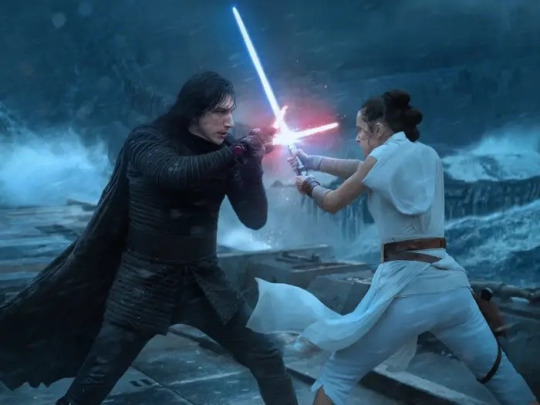
#mf ship bracket#mf ship bracket 2023#bonus round#kylo ren#rey#reylo#star wars#avatar: the last airbender#aang#katara#kataang#anti-reylo
59K notes
·
View notes
Text
I just watched Avatar for the first time all the way through, and yeah, it’s great, but the one thing that surprised me was how different Katara was compared to the fandom interpretation I’d seen and internalized before watching.
Like, before you watch Avatar, you’ve seen all these memes about Katara and her mom, and based on those memes, you assume it’s one of those lines you have to get used to hearing at least once every episode. But then you watch the show and realize that she only talks about her mom maybe five or six times per season and you also realize she only brings her up when she’s trying to comfort someone or empathize with them because that’s how she processes her grief and that’s one way she connects with people.

Or you hear the infamous line, “then you didn’t love [our mother] the way I did” and you prepare yourself for one of the worst character assassinations ever only to see the scene after nearly three seasons worth of context and realize she was kinda right. She’s been the mother, the nurturer, the comforter. She’s been patient, gentle, and accommodating where everyone else has gotten to be insensible and reckless and childish, and the one moment where she allows herself to feel her grief, suddenly she’s this evil bitch and not, y’know, a 14 year old girl whose been thrusted into adulthood in a way no other character has. A 14 year old girl who should be allowed immaturity and raw emotion and anger instead of the patience and grace she’s been forced to extend to every character without even the smallest amount of gratitude or even consideration in return.
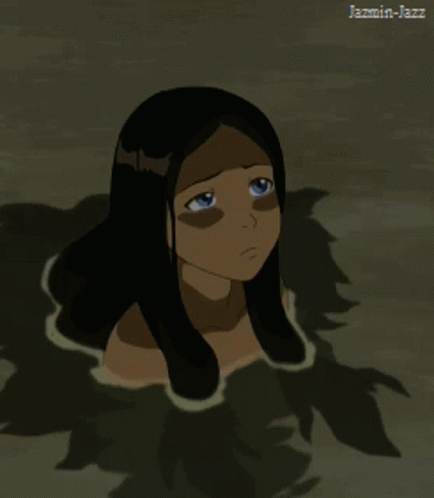
Or you see all of the clips where Katara puts Aang in the “friendzone” and you expect to have this wishy washy back and forth where Aang is putting his feelings out there only to have Katara neither commit nor express any clear reciprocation or rejection. Then you watch and realize that, as cute as the ship is initially, that there’s never a point where Aang returns any comfort or grace to Katara despite her always doing this for him to the point of coddling. That for as much as Aang says he loves her, he never seems to outgrow his perception of her so he can recognize her as someone who feels grief, anger, and pain as much as she expresses love, kindness, and maturity. And instead of having moments where he learns to see her beyond her strength or compassion, you’re instead given moments where Aang forces his feelings onto her, both romantic and non-romantic, and Katara is expected to just…shoulder those feelings the way she shoulders everyone else’s.
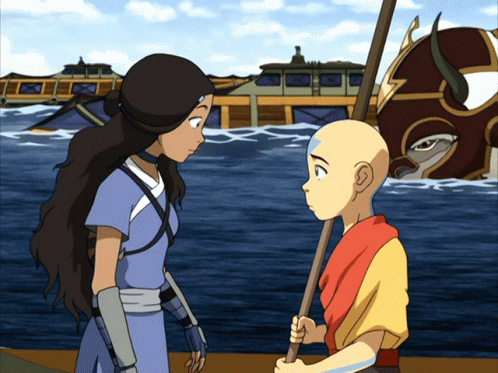
Katara is the most misunderstood character in the show. As much as people recognize the complexities of Zuko, Sokka, and Azula, they struggle to do the same for Katara because they see her struggles as somehow lesser, and therefore, less deserving of sympathy. They can handle her so long as she’s being endlessly patient and loving and kind, but the moment her endless love, patience, and kindness runs out, she’s suddenly this annoying bitch who can’t shut up about her mother or reciprocate Aang’s feelings. But Katara’s trauma does matter as much as anyone else’s. No, she wasn’t banished from her kingdom. No, she didn’t lose her entire community, and no, she isn’t the only one who lost her mother. But the difference between her and everyone else whose experienced loss because of the Fire Nation is that she’s never given time to process her trauma. Aang gets to lean on Katara constantly. Toph gets to express her feelings to Katara, and yeah, Sokka also lost their mother, but unlike Katara, he isn’t put in the position of being a substitute for everyone’s parent. He even admits that he sees his sister as a mother. The only characters who ever comfort Katara or allow her to vent is Zuko and her father and that’s, like, three scenes in a show where the other characters are consistently given opportunities to seek out Katara for unconditional support.

The fandom interpretation of Katara has been so bastardized that even those who haven’t watched the show know her for this fanon version and not for who she is. She’s such an interesting character beyond her fandom limitations, though. She’s brave, hot-headed, and hopeful as well as gentle and caring. She wishes to learn waterbending, not only because she wants to fight in the war, but because she wants to continue her culture’s practices because, and people often forget this, she also lost an entire subculture within her already fractured tribe. And she wants to defeat the Fire Nation both because of her deep love and empathy for other people, but also because she wants to avenge her mother. But because some of the fans have reduced Katara to a bitch who constantly whines about her mother and friendzones Aang, you wouldn’t know any of this, and it sucks because she’s the only character whose been dumbed down to such an extent.
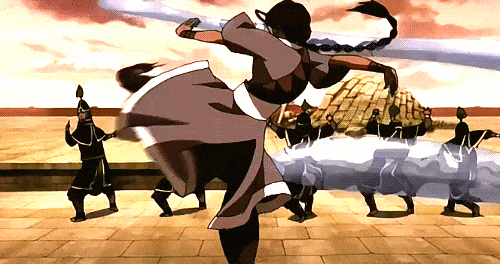
#avatar the last airbender#avatar#katara#you can tell she’s my favorite character#female character#zutara#I’m not anti or pro either#just something I noticed#I’m not against Aang either#just this writing
23K notes
·
View notes
Text
Ugh I will always love the concept of Katara using blood bending to revive Zuko after the last agni kai, mostly because it makes no sense to me that Zuko was able to bounce back so easily after being struck by lightning, but also because the way the show treats bloodbending is just odd to me. It was a defense mechanism created by a traumatized victim of some of the most devastating parts of colonization, and although I understand that Hama was supposed to symbolize the "bad parts" of waterbending and was important for Katara's growth in realizing that the world isn't entirely black and white, its still disappointing to me that the show never explored the gray areas of blood bending, especially since that episode was, as I stated above, about understanding the gray areas of the war. Katara using blood bending to revive Zuko would add so much to the last agni kai in demonstrating that she has truly realized that "good" and "evil" are relative concepts, and Zuko being saved by both a defense mechanism of a survivor of colonialism and a type of bending used to terrorize his people would have even added to his arc, as the narrative required him to save and subsequently be saved by the physical embodiment of everything his family sought to annihilate.
#also just the angst potential#there are so many fics and better metas written about this but I had to throw my two cents in#Bryke's refusal to acknowledge bloodbending as anything but evil incarnate is so fucking annoying#anti bryke#bloodbending#zutara#zuko#katara#final agni kai#atla#avatar the last airbender#atla meta#zutara meta#technically
4K notes
·
View notes
Text
"Zuko would take a lightning for anyone–"
But it was Katara that he chose to invite.
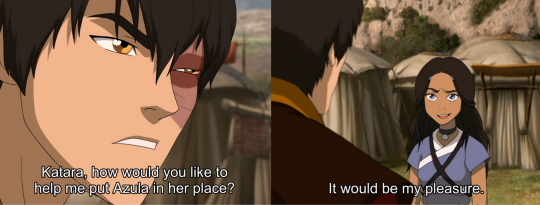
"Zuko would take a lightning for anyone–"
But Azula knew to aim at Katara.

"Zuko would take a lightning for anyone–"
But the scene was romamtically coded.
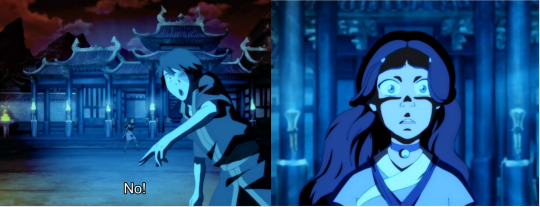
"Zuko would take a lightning for anyone–"
But Katara needed to get to heal him.
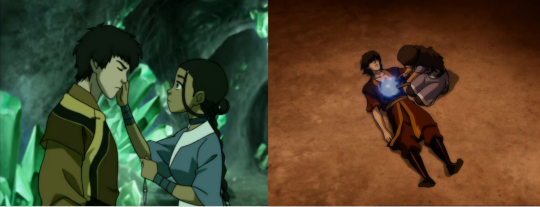
"Zuko would take a lightning for anyone–"
But it was Katara who was with him in season finales.

"Zuko would take a lightning for anyone–"
But he needed to choose Katara over Azula.

"Zuko would take a lightning for anyone–"
But Shu needed to survive in this life.

"Zuko would take a lightning for anyone–"
But the writers deliberately chose Katara.
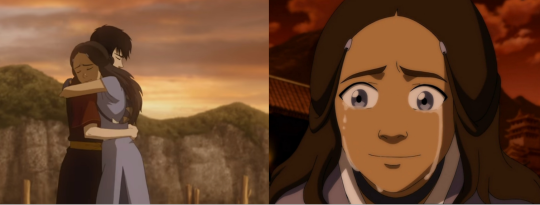
Inspired by @captain-konami-code 's "They were enemies"
#DISCLAIMER: I know this post isn't a full convincing argument. It's more for people who already agree.#it *definitely* falls under shitpost#zutara shitpost#<- the true nature of the post#zutara meta#<- for exposure#zutara#anti anti zutara#pro zutara#zuko x katara#katara x zuko#zukoxkatara#kataraxzuko#zutara analysis#zutara evidence#zutara forever#zutara nation#zutara was robbed#zutara supremacy#zutara should have been canon#atla critical#atla critisism#katara#zuko#prince zuko#katara of the southern water tribe
3K notes
·
View notes
Text
I think that one of the reasons I hate zutara and I like zukka is because the zukka fandom is pretty much the opposite of the zutara fandom.
I've never ever seen a post where someone tries to prove that zukka should've been canon or that it IS canon. Zutara shippers take every scene between the two and over analyze everything to the point that it's exhausting and annoying.
Zukka shippers don't do that, and most of the fandom is just like, "Haha, what if these two kissed?" And honestly, I love that sm more than the over analyzing
2K notes
·
View notes
Text
Katara's Story Is A Tragedy and It's Not An Accident
I was a teenaged girl when Avatar: The Last Airbender aired on Nickelodeon—the group that the show’s creators unintentionally hit while they were aiming for the younger, maler demographic. Nevermind that we’re the reason the show’s popularity caught fire and has endured for two decades; we weren’t the audience Mike and Bryan wanted. And by golly, were they going to make sure we knew it. They’ve been making sure we know it with every snide comment and addendum they’ve made to the story for the last twenty years.
For many of us girls who were raised in the nineties and aughts, Katara was a breath of fresh air—a rare opportunity in a media market saturated with boys having grand adventures to see a young woman having her own adventure and expressing the same fears and frustrations we were often made to feel.
We were told that we could be anything we wanted to be. That we were strong and smart and brimming with potential. That we were just as capable as the boys. That we were our brothers’ equals. But we were also told to wash dishes and fold laundry and tidy around the house while our brothers played outside. We were ignored when our male classmates picked teams for kickball and told to go play with the girls on the swings—the same girls we were taught to deride if we wanted to be taken seriously. We were lectured for the same immaturity that was expected of boys our age and older, and we were told to do better while also being told, “Boys will be boys.” Despite all the platitudes about equality and power, we saw our mothers straining under the weight of carrying both full-time careers and unequally divided family responsibilities. We sensed that we were being groomed for the same future.
And we saw ourselves in Katara.
Katara begins as a parentified teenaged girl: forced to take on responsibility for the daily care of people around her—including male figures who are capable of looking after themselves but are allowed to be immature enough to foist such labor onto her. She does thankless work for people who take her contributions for granted. She’s belittled by people who love her, but don’t understand her. She’s isolated from the world and denied opportunities to improve her talents. She's told what emotions she's allowed to feel and when to feel them. In essence, she was living our real-world fear: being trapped in someone else’s narrow, stultifying definition of femininity and motherhood.
Then we watched Katara go through an incredible journey of self-determination and empowerment. Katara goes from being a powerless, fearful victim to being a protector, healer, advocate, and liberator to others who can’t do those things for themselves (a much truer and more fulfilling definition of nurturing and motherhood). It’s necessary in Katara’s growth cycle that she does this for others first because that is the realm she knows. She is given increasingly significant opportunities to speak up and fight on behalf of others, and that allows her to build those advocacy muscles gradually. But she still holds back her own emotional pain because everyone that she attempts to express such things to proves they either don't want to deal with it or they only want to manipulate her feelings for their own purposes.
Katara continues to do much of the work we think of as traditionally maternal on behalf of her friends and family over the course of the story, but we do see that scale gradually shift. Sokka takes on more responsibility for managing the group’s supplies, and everyone helps around camp, but Katara continues to be the manager of everyone else’s emotions while simultaneously punching down her own. The scales finally seem to tip when Zuko joins the group. With Zuko, we see someone working alongside Katara doing the same tasks she is doing around camp for the first time. Zuko is also the only person who never expects anything of her and whose emotions she never has to manage because he’s actually more emotionally stable and mature than she is by that point. And then, Katara’s arc culminates in her finally getting the chance to fully seize her power, rewrite the story of the traumatic event that cast her into the role of parentified child, be her own protector, and freely express everything she’s kept locked away for the sake of letting everyone else feel comfortable around her. Then she fights alongside an equal partner she knows she can trust and depend on through the story's climax. And for the first time since her mother’s death, the girl who gives and gives and gives while getting nothing back watches someone sacrifice everything for her. But this time, she’s able to change the ending because her power is fully realized. The cycle was officially broken.
Katara’s character arc was catharsis at every step. If Katara could break the mold and recreate the ideas of womanhood and motherhood in her own image, so could we. We could be powerful. We could care for ourselves AND others when they need us—instead of caring for everyone all the time at our own expense. We could have balanced partnerships with give and take going both ways (“Tui and La, push and pull”), rather than the, “I give, they take,” model we were conditioned to expect. We could fight for and determine our own destiny—after all, wasn’t destiny a core theme of the story?
Yes. Destiny was the theme. But the lesson was that Katara didn’t get to determine hers.
After Katara achieves her victory and completes her arc, the narrative steps in and smacks her back down to where she started. For reasons that are never explained or justified, Katara rewards the hero by giving into his romantic advances even though he has invalidated her emotions, violated her boundaries, lashed out at her for slights against him she never committed, idealized a false idol of her then browbeat her when she deviated from his narrative, and forced her to carry his emotions and put herself in danger when he willingly fails to control himself—even though he never apologizes, never learns his lesson, and never shows any inclination to do better.
And do better he does not.
The more we dared to voice our own opinions on a character that was clearly meant to represent us, the more Mike and Bryan punished Katara for it.
Throughout the comics, Katara makes herself smaller and smaller and forfeits all rights to personal actualization and satisfaction in her relationship. She punches her feelings down when her partner neglects her and cries alone as he shows more affection and concern for literally every other girl’s feelings than hers. She becomes cowed by his outbursts and threats of violence. Instead of rising with the moon or resting in the warmth of the sun, she learns to stay in his shadow. She gives up her silly childish dreams of rebuilding her own dying culture’s traditions and advocating for other oppressed groups so that she can fulfill his wishes to rebuild his culture instead—by being his babymaker. Katara gave up everything she cared about and everything she fought to become for the whims of a man-child who never saw her as a person, only a possession.
Then, in her old age, we get to watch the fallout of his neglect—both toward her and her children who did not meet his expectations. By that point, the girl who would never turn her back on anyone who needed her was too far gone to even advocate for her own children in her own home. And even after he’s gone, Katara never dares to define herself again. She remains, for the next twenty-plus years of her life, nothing more than her husband's grieving widow. She was never recognized for her accomplishments, the battles she won, or the people she liberated. Even her own children and grandchildren have all but forgotten her. She ends her story exactly where it began: trapped in someone else’s narrow, stultifying definition of femininity and motherhood.
The story’s theme was destiny, remember? But this story’s target audience was little boys. Zuko gets to determine his own destiny as long as he works hard and earns it. Aang gets his destiny no matter what he does or doesn’t do to earn it. And Katara cannot change the destiny she was assigned by gender at birth, no matter how hard she fights for it or how many times over she earns it.
Katara is Winston Smith, and the year is 1984. It doesn’t matter how hard you fight or what you accomplish, little girl. Big Brother is too big, too strong, and too powerful. You will never escape. You will never be free. Your victories are meaningless. So stay in your place, do what you’re told, and cry quietly so your tears don’t bother people who matter.
I will never get over it. Because I am Katara. And so are my friends, sisters, daughters, and nieces. But I am not content to live in Bryke's world.
I will never turn my back on people who need me. Including me.
#ATLA#Avatar the Last Airbender#Katara#Anti Bryke#Zutara#but not really#just pro-Katara#Anti Kataang
2K notes
·
View notes
Text
There was yet another viral ATLA comparison tweet recently that went “Who winning in a fight between Katara, Toph and Azula?” and I was talking about it with some of my friends who watched the show because….
I noticed when a lot of people talk about this (and atla in general but specifically this) they talk with a lot of projection and bias of the characters’ personalities and not about their actual fighting abilities in the show?
Because, correct me if I’m wrong cuz I have Katara blinders and also haven’t watched the show in a few months so I COULD BE WRONG, but…
I don’t recall Katara losing as many fights as either of them do in canon.
Toph loses a fight in imbalance (and to Aang when they first meet) but a lot of people haven’t even read the comics so the Katara-Toph comparisons bother me less because they never truly fought in the show either.
But Katara has not only beat Azula twice, she’s also never lost a fight after season 1 from what I can remember.
And yet, people continue to act like she’s not a great fighter, especially in favor of those two when she’s literally the only one to beat one of the others, TWICE at that.
When Toph meets Azula in the invasion, Azula doesn’t have her bending and Toph is left to fight two Dai Li agents. The show never once shows these 2 in direct opposition. Toph also never has to fight Zuko, who Katara has. Never fights Mai and Ty Lee, who Katara has. Katara not only has more wins than them, but the show also shows her directly fighting more significant opponents between the three of them.
I actually wanna speak about two of those fights, yeah yeah Sozin’s Comet but also, the 1v1 in Ba Sing Se. Not only do people cry “oh Azula was breaking down in the finale” but now they claim that the fight in season 2 was also not fair? because she was too tired from fighting Aang and Katara?? And I’m like??? Aang made one waterbending move with Katara and one solo earthbending move at Azula before Zuko switched sides and started attacking him. Then Katara was left to fight Azula on her own for far longer, and throughout the whole fight, Azula literally did not get a hit on Katara once, to the point her brother had to intervene.
If you ask me, their fight on Sozin’s comet is a much stronger case for Azula as an opponent. For one, Azula was literally overpowered by a comet and was shooting lightning and fire all over the place with more intensity and speed than she ever had. Meanwhile Katara spends majority of the fight on the defensive but still impressively keeps up with Azula enough to dodge her moves until the very end when she defeats her.
All this to say, even though they’re all girls, I do feel a bit of misogyny is at play here: I feel like people are more critical of Katara as a fighter because she’s kind, girly and the female love interest. (I think this also relates to why so many people insist she shouldn’t have ended up with the mc but that’s a whole other discussion).
Katara is not the tomboy brawler or the cold blooded villain. Her femininity cannot be ignored and her strength cannot be tied to a villainous narrative. Katara not wanting to bloodbend pisses people off, because it’s “more proof she doesn’t have what it takes”. She doesn’t “have the stomach” to end her mother’s m*rderer so how can she beat Toph or Azula? “Female characters are hardly both healers AND fighters” so Katara automatically isn’t either. Even though the canon explicitly shows she is one of, if not THE BEST female fighter in the entire cast.
It does not compute. Their prejudice for kind hyperfeminine love interests in media automatically puts her down several notches and her strength is something to be contested in a way theirs aren’t. It’s okay for female characters that aren’t overly feminine to be strong because it just makes sense. It’s ok for female villains to be stronger than the male heroes because that’s what makes them badass villains. The hero’s girlfriend? eh not so much.
The more blatant misogyny starts to surface when they start talking about stuff like personality and emotion like just say it out loud at this point! It was never about “Who you want to win?” but “Who can win?”. And Katara is anything but a loser.
#atla#katara#atla fandom problems#was not expecting this to be this long#but i’m sorry it just pissed me off#clearly i was in a katara mood today#like the blatant disrespect and just sheer misogyny i was seeing in those quotes#UGH#this will be my only rant for the month I promise#wish people would just stop talking about this show in general so i don’t have to see it#antizutara#anti zutara#anti anti katara
41 notes
·
View notes
Text
Fanon:
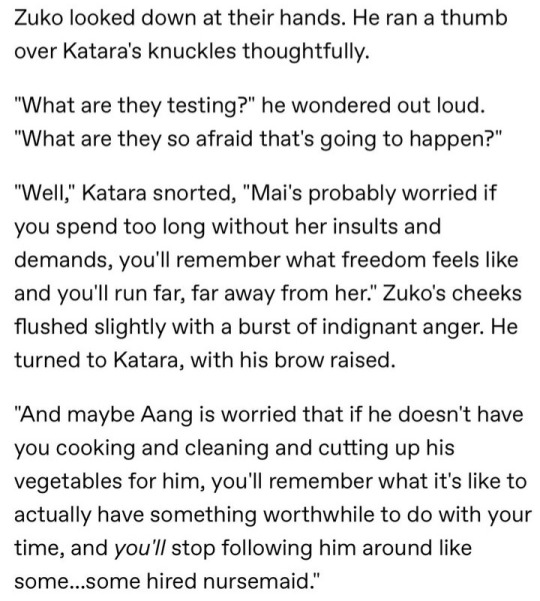
Canon:
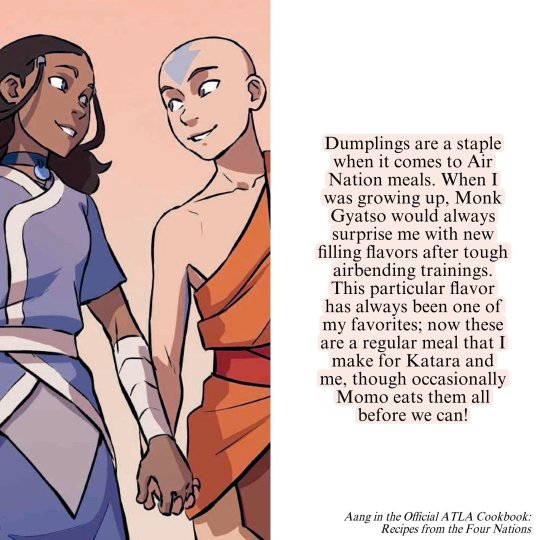

This man is a MALEWIFE
Another L for Aang's delusional haters
#avatar the last airbender#aang#katara#kataang#atla#another L for that fanbase#i will defend aang with my life#i'm so tired of these weirdos#LEAVE HIM ALONE#also the mai hate ewww#anti zut*ra#anti zu*o stans
3K notes
·
View notes
Text
I'm so tired of people telling those of us who are upset about the LA atla remake that we are "being too dramatic" or are just "finding things to be upset about". We are allowed to be upset that something that we love so dearly has been butchered, AGAIN. If you liked it, then that's your personal opinion, but don't sit here and tell those of us who didn't that we're the problem.
I personally think the CGI, costumes, and sets all look terrible. None of it is immersive. Sure, it LOOKS like atla, but it doesn't FEEL like atla. The heart of the og is gone, and people are allowed to be upset about this. They've altered characters to the point that they aren't the character anymore (looking at you Aang and Katara), which is a huge upset for me personally because Katara is one of my favorite characters ever. So watching her be turned into someone meek and docile is more than a slap to the face. Not to mention them removing her as the narrator as if Bryke themselves didn't state that Katara is the person the story is being told through. And before you start telling me that Aang is the same. No, he isn't. Major parts of his development through season 1 (him coming to terms with the fact that he's the avatar and embracing that role, and him also accepting the fact that he RAN AWAY and how he is never going to do that again, which is also pivotal to his character later on) are completely removed. And don't even get me started on what they did to Kataang. Regardless of whether you ship them or not, those 2 are deeply connected to one another from the start, and their relationship is a big part of the show, so to see that butchered is heartbreaking for me.
This isn't just about them "making some changes" or it not being a 1:1 adaptation. I'm fine with adaptations that aren't 1:1. What I'm upset about is that the changes they are making are VITAL changes to characters and dynamics between characters. They're rushing through the plot and condensing the story (and I will scream if I hear one more person say that it's because they couldn't fit it all in with their runtime. The runtime is an HOUR LONGER than the og, so yes, they did have the time). The changes they are making make it evident that they do not understand the og show, and if you don't feel like that, fine, once again, that's YOUR opinion, just as this is MY opinion. So stop telling us we have no right to be upset and that we just want to hate everything. That's not true. What is true is that we are expressing valid complaints about another bad adaptation of something dear to us.
Edit: If you also come at people who are upset bc they were expecting a faithful adaptation and didn't get it bc "its not supposed to be the cartoon," you're missing the whole point. An adaptation is ADAPTING SOMETHING from one medium to the other, not rewriting it. "Yall expected it to be just like the cartoon." No, I expected a FAITHFUL ADAPTATION and was met with poorly written fanfiction.
#atla#avatar the last airbender#natla#netflix avatar#katara#aang#kataang#never made a post before but it had to be said bc it was starting to make me mad#atla is my favorite show of all time#stop trying to dictate how i feel about the remake#there is no live action in ba sing se#anti natla#anti LA atla
2K notes
·
View notes
Text
Something that I think ppl who ship both sukka and zutara don't acknowledge enough is the fact that poor Hakoda met both his kids' future spouses on the same day, in the same place and that place just happened to be prison.
#Hakoda: Wow Sokka's girlfriend is the imprisoned leader of an elite team of warriors surely it can't get more complicated now#*sees his daughter interacting for twenty-seconds with the exiled traitor prince of an enemy nation*#Hakoda: uh oh#those kids are the best 16 year migraine this man has ever had#my posts#zutara#sukka#zuko x katara#sokka x suki#wanted to put something fun in the zk tag since i've seen to many antis lurking in there#and i've got like half this fandom blocked already!
1K notes
·
View notes
Text
the anti-Zutara criticism that “Zutara shippers are teenage girls who only like the ship because they self-insert as Katara” is actually so funny because how does that delegitimize the ship? So…girls who relate to Katara like Zuko, and they think Katara would like Zuko, and that’s bad because…girls are wrong? Girls are shallow? Girls don’t know what’s good for them?
Anyway if I were a grown ass man who created a fictional teenage girl that lots of real teenage girls relate to, and these girls believe she would like character B instead of character A, I hope I’d have the humility to say to myself “hmm I wonder why people who relate to this character’s feelings and motivations think she would react this way” instead of jumping straight to “these girls are doomed to like toxic relationships”
(And I know Zutara shippers like the ship for many different reasons, and self-insert is not the most popular by a long shot, I’m just saying that the criticism of self-insert stems from dismissal of what teenage girls like, and that feels kinda misogynistic to me)
#Zutara#pro Zutara#anti bryke#katara#Anti kataang#not really anti kataang but tagging it just in case#I should tag this “pro teenage girls”#My meta
1K notes
·
View notes
Text
i will always hate that katara never came to terms with her bloodbending. especially given that it’s a symbolic representation of her own “darker” side, the fact that she was never able to find the good in it and accept it as just another aspect of her element, instead outlawing and demonizing it forever, makes me so sad because it perfectly encapsulates the person she herself ended up as: the shallow, shining trophy wife on aang’s arm, locking away everything he didn’t want and was never able to understand to become his perfect, flawless forever girl for the rest of her days.
and it’s so much more frustrating knowing that zuko — who knows exactly what it feels like to wield an element that can be destructive and violent, whose own arc about the duality of fire would have made him the perfect person to help katara understand that there is no such thing as inherently good or evil bending, only the bender who makes it so — was right there! yet instead of letting them have even one conversation about it, we got bloodbending being villainized till the heat death of the fucking universe and katara left forever unable to accept the complexity of her bending (and metaphorically, the complexity within herself) even though she had the exact person she needed right at hand to help and support her through the process… god it just drives me mad
2K notes
·
View notes